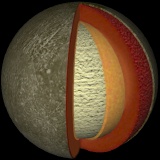| THE EVOLUTION OF MERCURY | |
| Mercury is unique amongst the rocky inner planets because it has an extremely high average density. Since Mercury is also quite small, this suggests that the interior of Mercury is composed of heavy materials. Geologists think that Mercury has a core made of iron and nickel, comprising 75% of the planet's radius. But how did Mercury come to be like this? | |
| There are two alternative explanations. It is generally accepted that the planets of the solar system formed in a process known as accretion whereby primitive solar system bodies collide with one another, and with time grow in size. As the process continued, smaller asteroids and debris collide with the larger and gravitationally more powerful planets contributing to their mass. Mercury simply formed close to the Sun where the material containing the heaviest elements was concentrated. Other people have suggested that the lighter elements that might once have existed on Mercury were stripped away by a collision with a mystery planetesimal which left behind only part of the mantle and a large iron-nickel core. | |
| Apart from the interior being mostly heavy metal, we lack any detailed idea of how the core, or the mantle of Mercury, might be structured. However, because volcanism formed lava plains on the surface of Mercury it appears that the mantle was once layered according to the density of its constituents or its chemical differentiation. This layering occurs through gravitational settling, whereby heavier elements are concentrated deeper. Studies of the surface chemistry, by examining the light reflected from Mercury, show this to be the case. There appears to be less titanium on the surface of Mercury than on the Moon because Mercury's greater gravitational strength pulled it deeper. | |
 The interior of Mercury. |
|
| Geological activity on Mercury ended a long time ago, as indicated by the survival of so many craters on Mercury from the early history of the solar system. Volcanism on Mercury ceased several thousand million years ago, as the molten silicate mantle quickly cooled and solidified. The upper rocky layer, or crust, becoming thicker as the deeper mantle 'froze'. Volcanic activity was halted probably before the mantle had completely solidified, because as the planet cooled down it also shrank, sealing up the cracks in the surface which had enabled lava to reach the surface. | |
|
|
|